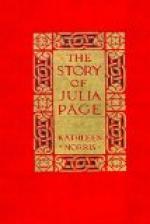Julia and Connie were early to-night, and took their regular places at a long table that was as yet surrounded only by empty chairs. Madame, who was feeding bread and milk to a black-eyed three-year-old at a little table in a corner, nodded a welcome, and a young Frenchwoman, putting her head in through a swinging door at the back, nodded, too, and said, showing a double row of white teeth:
“Wait—een?”
“Yes, we’ll wait for the others!” Connie called back. She and Julia nibbled French bread, and played with their knives and forks while they waited.
The dining-room had that aspect of having been made for domestic and adapted to general use that is so typically un-American, yet so dear to the American heart. An American manager would have torn down partitions, papered in brown cartridge, curtained in pongee, and laid a hardwood floor. Monsieur Montiverte left the two drawing-rooms as they were: a shabby red carpet was under foot, stiff Nottingham curtains filtered the bright sunlight, and an old-fashioned paper in dull arabesques of green and brown and gold made a background for framed dark engravings, “Franklin at the Court of France,” and “The Stag at Bay,” and other pictures of their type. The tablecloths were coarse, the china and glass heavy, and the menus were written in blue indelible pencil, in a curly French hand. From the windows at the back one could look out upon an iron-railed balcony, a garden beyond, and the old, brick, balconied houses of the Chinese quarter. At the left the California Street cable car climbed the hill, and the bell tower of old St. Mary’s rose sombre and dignified against the soft sunset sky. At the right were the Park, with a home-going tide pouring through it at this hour, and Kearney Street with its jangling car bells, and below, the square roofs of the warehouse district, and the spire of the ferry building, and the bay framed in its rim of hills. Montiverte owned the house in which he conducted his business; it was one of the oldest in the city, built by the French pioneers




